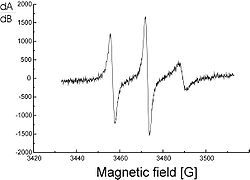
Spin label
Encyclopedia

Electron
The electron is a subatomic particle with a negative elementary electric charge. It has no known components or substructure; in other words, it is generally thought to be an elementary particle. An electron has a mass that is approximately 1/1836 that of the proton...
, usually on a nitrogen
Nitrogen
Nitrogen is a chemical element that has the symbol N, atomic number of 7 and atomic mass 14.00674 u. Elemental nitrogen is a colorless, odorless, tasteless, and mostly inert diatomic gas at standard conditions, constituting 78.08% by volume of Earth's atmosphere...
atom, and the ability to bind to another molecule. Spin labels are normally used as tools for probing protein
Protein
Proteins are biochemical compounds consisting of one or more polypeptides typically folded into a globular or fibrous form, facilitating a biological function. A polypeptide is a single linear polymer chain of amino acids bonded together by peptide bonds between the carboxyl and amino groups of...
s or biological membrane
Biological membrane
A biological membrane or biomembrane is an enclosing or separatingmembrane that acts as a selective barrier, within or around a cell. It consists of a lipid bilayer with embedded proteins that may constitute close to 50% of membrane content...
-local dynamics using EPR
Electron paramagnetic resonance
Electron paramagnetic resonance or electron spin resonance spectroscopyis a technique for studying chemical species that have one or more unpaired electrons, such as organic and inorganic free radicals or inorganic complexes possessing a transition metal ion...
spectroscopy. The site-directed spin labeling
Site-directed spin labeling
Site-directed spin labeling is a technique for investigating protein local dynamics using electron spin resonance. The theory of SDSL is based on the specific reaction of spin labels with amino acids. A spin label's built-in protein structure can be detected by EPR spectroscopy...
(SDSL) technique allows one to monitor a specific region within a protein. In protein structure examinations, amino acid
Amino acid
Amino acids are molecules containing an amine group, a carboxylic acid group and a side-chain that varies between different amino acids. The key elements of an amino acid are carbon, hydrogen, oxygen, and nitrogen...
-specific SLs can be used.
The goal of spin labeling is somewhat similar to that of isotopic substitution in NMR spectroscopy
NMR spectroscopy
Nuclear magnetic resonance spectroscopy, most commonly known as NMR spectroscopy, is a research technique that exploits the magnetic properties of certain atomic nuclei to determine physical and chemical properties of atoms or the molecules in which they are contained...
. There one replaces an atom lacking a nuclear spin (and so is NMR-silent) with an isotope having a spin I
 0 (and so is NMR-active). This technique is useful for tracking the chemical environment around an atom when full substitution with an NMR-active isotope is not feasible. Recently, spin-labelling has also been used to probe chemical local environment in NMR itself, in a technique known as Paramagnetic Relaxation Enhancement (PRE).
0 (and so is NMR-active). This technique is useful for tracking the chemical environment around an atom when full substitution with an NMR-active isotope is not feasible. Recently, spin-labelling has also been used to probe chemical local environment in NMR itself, in a technique known as Paramagnetic Relaxation Enhancement (PRE).

